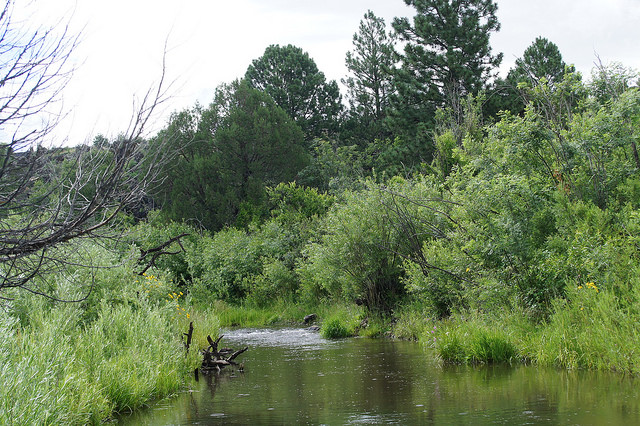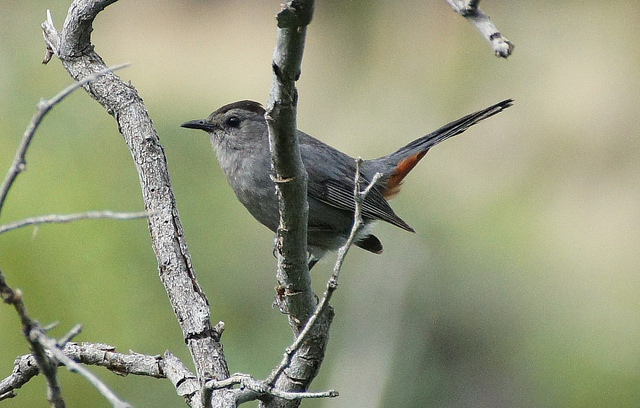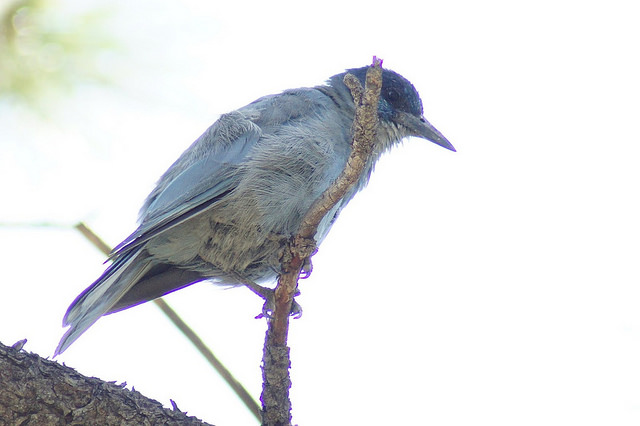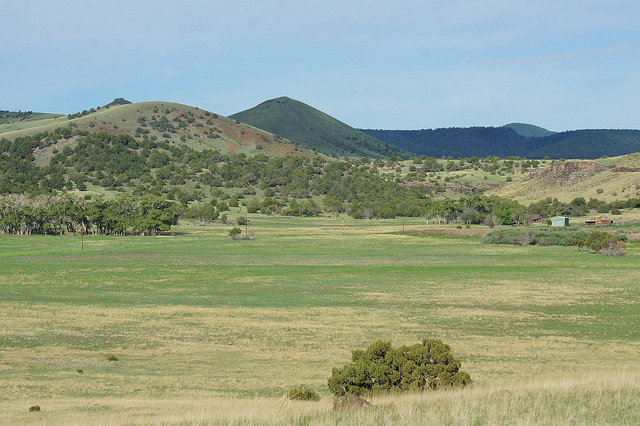Highway 260-East of Highway 373 to Eagar

Birding in areas accessed off of this stretch of Highway 260 have a lot to offer. There are a variety of habitats to explore, and as a result of those many habitats, there are a variety of different bird species. The main birding hotspots in this area are the South Fork of the Little Colorado River and the White Mountain Grasslands Wildlife Area. Explore high elevation grassland, rocky hillsides, ponds, mountain riparian, juniper and pinyon forest, and ponderosa pine forest within this area. Neat birds you may see include Golden Eagle, Burrowing Owl, Montezuma Quail, White-throated Swift, Gray Catbird, Juniper Titmouse, Gray Flycatcher, Pinyon Jay, and many more.
Getting to the Highway 260 Area (From Highway 373 east to Eagar): If traveling east on Highway 260, this specific stretch and area of Highway 260 is 50 miles east of Show Low and is just east after the Greer turnoff at Highway 373. Vise versa, if traveling west on Highway 260 from Eagar, one is in this area.

Area Overview Map: View link here- Highway 260-East of Highway 373 to Eagar Overview
South Fork of the Little Colorado River: The turnoff for the South Fork of the Little Colorado River is between mileposts 390 and 391 on the south side of Highway 260. This is 5.5 miles west of Eagar. Take this turnoff and follow the paved road (County Road 4124) into the valley of South Fork below. South Fork is an outstanding birding area, and there are many different habitats in a relatively small area. Such habitats include grassland, rocky bluffs, juniper and pinyon-pine, riverside riparain habitat, ponderosa pine forest, and mixed conifer and apsen forest. After two miles of driving south on County Road 4124 into South Fork, the road crosses over the Little Colorado River. Just north of the bridge and river crossing is a pulloff for parking. The habitat here is thick riparian habitat along the river with rocky bluffs and juniper and pinyon-pine trees to the north. This is a well known location for finding Gray Catbirds in the White Mountains. Most outings in late spring and summer to this location will produce a Gray Catbird sighting with some patience. Other birds to look and listen for along the river and in the surrounding habitat here include Montezuma Quail, Golden Eagle, White-throated Swift, Pinyon, Steller's and Western Scrub-Jays; Juniper Titmouse, Bushtit, Rock and Canyon Wrens, American Dipper (on occasion), Yellow-breasted Chat, Spotted and Canyon Towhees, Black-headed and Blue Grosbeaks, and Indigo Bunting. From this bridge at 2 miles on the road, proceed further south past this bridge for nearly a mile to the South Fork Day Use Area and Trailhead for the seven mile South Fork Trail. The day use area used to be a campground before the Wallow Fire took place in 2011. This area is at a higher elevation than the first stop along the river. A pleasant and lush ponderosa pine and Douglas fir forest is now accessed with more riparain habitat to explore along the Little Colorado River. There are cottonwoods lining the river throughout this stretch of the area. The first mile of the South Fork Trail is pleasant before it enters heavily burned areas from the Wallow Fire. The slopes above the day use area with sections of pinyon-pine are excellent for viewing Pinyon Jay. A morning stop is likely to produce good views of this energetic corvid. In this upper elevation of the area, other birds to keep eyes and ears out for include Golden Eagle, Northern Pygmy-Owl, Common Nighthawk, Williamson's and Red-naped Sapsuckers, Clark's Nutcracker, Brown Creeper, Townsend's Solitaire, MacGillivray's, Virginia's, Grace's, and Red-faced Warblers; and Hepatic Tanager. South Fork has been known for producing rarities, especially in the past. Veery and American Redstart have bred in this area, and the only known Swainson's Warbler record for Arizona is from South Fork. For a separate page with more information on South Fork with pictures of birds and scenes from the location, hotspot links to eBird, and maps of the area, click on the link here- South Fork of the Little Colorado River

White Mountain Grasslands Wildlife Area: To reach the White Mountain Grasslands Wildlife Area, turn north of the 260 at the sign labeled "Refuse Transfer Station" between milemarkers 391 and 392. This turnoff is about a half-mile east of the turnoff to the South Fork of the Little Colorado River area and this turnoff is also about 5 miles west of Eager. Once turning north on the paved road toward the Transfer Station and heading north for 0.3 miles, head to the west (left) on a sharp-left turn where the pavement continues to head west. At this point, continue on this paved road for another 0.3 mile and look for a dirt road just on the south side of this paved road that veers off to the western direction while the paved road continues to head in the northern direction. Take this dirt road, which is followed for 2.8 miles, to the Grasslands Wildlife Area. This road is in good condition and works just fine for passenger vehicles. At 2.45 miles of driving on this dirt road, there is another side road that veers off to the right and heads north. Ignore this road and keep heading west for another 0.3 mile to the parking area. The Grasslands Wildlife Area is a beautiful and peaceful location to bird at. Habitat mainly consists of high elevation grasslands, of course. There are also slopes with juniper forest on them, which can be quite productive for a number of species. An old homestead was once on this area, and it was purchased when this Wildlife Area was made. Several groves of cottonwood trees as well as a few ponds are in the area. The cottonwood groves hold good habitat for migrants in spring and fall, and the ponds have shorebird potential. From the parking lot, there are two paths to take through Grasslands Wildlife Area. One is the 2.6 mile Ocote Trail, which is a nice and rather lengthly hike through the area. Other than some climbing in the beginning stretches and a few other climbs throughout the trail, this hike is fairly easy. This gives one the best chance of seeing a variety of birds and maybe some other wildlife. The other route is a dirt road that heads west from the main dirt road one comes into the Wildlife Area, as foot travel is only permitted past the parking lot. Follow this road in the western direction through the fence for 0.8 mile to the old homestead. This path goes along juniper woodland, the cottonwood groves, two ponds, and grassland habitat. Both routes are highly suggested and are worth exploring, although the Ocote Trail is best for getting more of a grassland experience as the western side of the Ocote Trail and the road to the homestead have more juniper habitat around them. A good variety of birds can be found here despite the name of this place. Mountain Plover and Long-billed Curlew have bred in this area in the past. Near the parking area and very beginning stretch of the road to the Wildlife Area, Burrowing Owl homes have been made. Although they usually tend to be vacant, it is worth checking for them. Birds seen in late spring and summer in this area include Red-tailed Hawk, Hairy Woodpecker, American Kestrel, Prairie Falcon, Gray Flycatcher (local breeder in the White Mountains in juniper forest, listen for it's dry "whit" call), Ash-throated Flycatcher, Western Kingbird, Loggerhead Shrike, Pinyon Jay, Western Scrub-Jay, Horned Lark, Mountain Chickadee, Bushtit, Juniper Titmouse, Rock Wren, both Mountain and Western Bluebirds, Townsend's Solitaire, Canyon Towhee, Hepatic Tanager, Blue Grosbeak, both Eastern and Western Meadowlarks, and Bullock's Oriole. As mentioned before, check the cottonwood stands and ponds during migrations. Winter birding here would be worth checking for Ferruginous Hawks and other raptors, and grassland dwellers such as Longspurs. For more information on White Mountain Grasslands Wildlife Area that contains pictures of the birds and scenes of the area, an eBird hotspot link, and area maps, a separate page is available for the location at the link here- White Mountain Grasslands Wildlife Area

Back to White Mountain Birding Areas |
